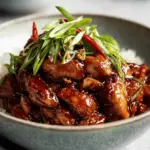This Asian Baked Teriyaki Salmon is a quick and flavorful dish perfect for busy weeknights. With just four ingredients and minimal prep time, you can enjoy a moist and flaky salmon dinner in under 30 minutes. Baking the salmon in foil ensures it stays juicy, while the teriyaki glaze adds a sweet and savory flavor. It’s a healthy option rich in omega-3 fatty acids and high-quality protein.
Full Recipe:
Ingredients
- 4 salmon filets
- 2 tablespoons soy sauce
- 3 tablespoons teriyaki sauce
- 1 tablespoon rice wine
- Freshly cracked black pepper, to taste
Directions
- Preheat the oven to 375°F (190°C).
- Line a baking dish with foil, covering the bottom and sides.
- In the lined dish, combine soy sauce, teriyaki sauce, and rice wine.
- Place the salmon filets in the dish, flipping them to coat both sides with the sauce. Ensure the filets are not touching each other.
- Sprinkle freshly cracked black pepper over the salmon to taste.
- Bake for 15–20 minutes, depending on the thickness of the filets. The salmon is done when it flakes easily and has a uniform color throughout.
Nutritional Facts (per serving)
- Calories: 250 kcal
- Carbohydrates: 4 g
- Protein: 40 g
- Fat: 11 g
- Saturated Fat: 1.9 g
- Cholesterol: 109 mg
- Sodium: 457 mg
- Potassium: 1004 mg
- Sugar: 2.4 g
- Iron: 0.4 mg
Health Benefits of Salmon
Salmon is often heralded as one of the healthiest fish available, and for good reason. It is rich in omega-3 fatty acids, which are crucial for maintaining heart health. These essential fats help reduce inflammation, lower blood pressure, and decrease the risk of heart disease. Regular consumption of salmon has been linked to improved brain function and reduced risk of age-related cognitive decline.
In addition to omega-3s, salmon is an excellent source of high-quality protein that supports muscle repair and growth. It is also loaded with important nutrients like vitamin B12, vitamin D, selenium, and potassium. Vitamin B12 supports nerve function and helps in the formation of red blood cells, while vitamin D is vital for bone health. Selenium acts as an antioxidant, protecting cells from damage, and potassium helps regulate blood pressure.
Because salmon is naturally low in calories yet high in nutrients, it is a great choice for those looking to maintain or lose weight without sacrificing taste or satisfaction. When paired with a flavorful glaze such as teriyaki sauce, it becomes a balanced dish that can be enjoyed by the whole family.
The Magic of Teriyaki Sauce
Teriyaki sauce is a popular Japanese condiment made from soy sauce, mirin (a sweet rice wine), sugar, and sometimes ginger or garlic. It is known for its sweet and savory flavor profile, which perfectly complements a variety of proteins, including chicken, beef, and seafood. When used with salmon, teriyaki sauce adds a delightful glaze that caramelizes during cooking, enhancing the natural flavors of the fish.
One of the appealing aspects of teriyaki sauce is its versatility. It can be used as a marinade, a cooking sauce, or a finishing drizzle, depending on the recipe. In baked salmon recipes, it acts as both a marinade and glaze, helping the fish stay moist while adding layers of flavor. Homemade or store-bought teriyaki sauces both work well, allowing flexibility depending on your preference and time constraints.
In addition to its great taste, teriyaki sauce contains soy sauce, which is a source of umami — often described as the fifth taste. Umami adds depth and complexity to dishes, making them more satisfying and flavorful. The slight sweetness from mirin or sugar balances the saltiness of the soy sauce, creating a harmonious blend that pairs beautifully with the rich salmon.
Why Bake in Foil?
Baking salmon in foil is a cooking method that has several advantages. Wrapping the fish in foil creates a steam pocket, which traps moisture and heat, cooking the salmon evenly and preventing it from drying out. This method ensures the salmon remains tender, juicy, and flaky, enhancing the overall eating experience.
Another benefit of using foil is the easy cleanup it provides. Since the sauce and juices are sealed inside, there is little mess to clean afterward. This makes the dish especially appealing for busy individuals or families looking for a quick but satisfying meal without much fuss.
Additionally, baking in foil allows the flavors of the marinade to fully infuse the fish. The enclosed environment keeps the teriyaki sauce close to the salmon, allowing it to penetrate deeply and impart its delicious taste. The result is a perfectly cooked salmon filet that bursts with flavor in every bite.
Serving Suggestions and Pairings
Asian Baked Teriyaki Salmon pairs wonderfully with a wide range of side dishes, making it easy to customize for different tastes and occasions. Classic pairings include steamed jasmine or brown rice, which absorb the extra teriyaki sauce and complement the rich fish perfectly. For a low-carb option, steamed or roasted vegetables such as broccoli, bok choy, or asparagus provide a fresh and nutritious balance.
Salads with light, citrus-based dressings can also work well alongside this dish, helping to cut through the richness of the salmon and add a refreshing contrast. Popular salad choices include cucumber salad, Asian slaw, or mixed greens with sesame dressing.
For a more indulgent meal, consider serving the salmon with garlic mashed potatoes or noodles tossed in a light soy-ginger sauce. These hearty sides enhance the comforting aspect of the dish and make it suitable for family dinners or entertaining guests.
Finishing the dish with garnishes like sliced green onions, toasted sesame seeds, or fresh cilantro adds texture and visual appeal. A wedge of lemon or lime on the side can also be squeezed over the fish to brighten the flavors just before eating.
Tips for the Best Results
To get the most out of your Asian Baked Teriyaki Salmon, here are some helpful tips:
-
Choose fresh, high-quality salmon filets with skin on for better flavor and moisture retention.
-
Marinate the salmon for at least 15 minutes before baking to allow the flavors to seep in.
-
Use heavy-duty aluminum foil to prevent tearing and ensure the juices stay sealed.
-
Do not overcook the salmon; check for doneness around 15 minutes and remove from the oven as soon as it flakes easily with a fork.
-
Experiment with adding minced garlic, ginger, or chili flakes to the teriyaki sauce for an extra flavor boost.
-
Let the salmon rest for a few minutes after baking to allow the juices to redistribute.
Cultural Significance of Teriyaki and Salmon in Asian Cuisine
Teriyaki cooking originates from Japan and has become a beloved method across the world, especially in Western countries. The name “teriyaki” refers to the shiny glaze that results from cooking with soy sauce and sugar-based sauces, creating a visually appealing and delicious finish.
Salmon is a popular fish in many Asian cuisines, valued for its rich taste and nutritional benefits. In Japan, salmon is commonly enjoyed raw as sashimi or sushi, but it’s also cooked in various ways, including grilling and baking. Teriyaki salmon combines two culinary traditions — the healthful qualities of salmon and the bold flavors of teriyaki — making it a favorite for those seeking a fusion of taste and nutrition.
Conclusion
Asian Baked Teriyaki Salmon is more than just a meal; it’s an experience that brings together flavor, health, and simplicity. This dish offers an easy way to enjoy a nutritious and delicious dinner without spending hours in the kitchen. The combination of tender, flaky salmon with the sweet-savory teriyaki glaze makes every bite memorable.






